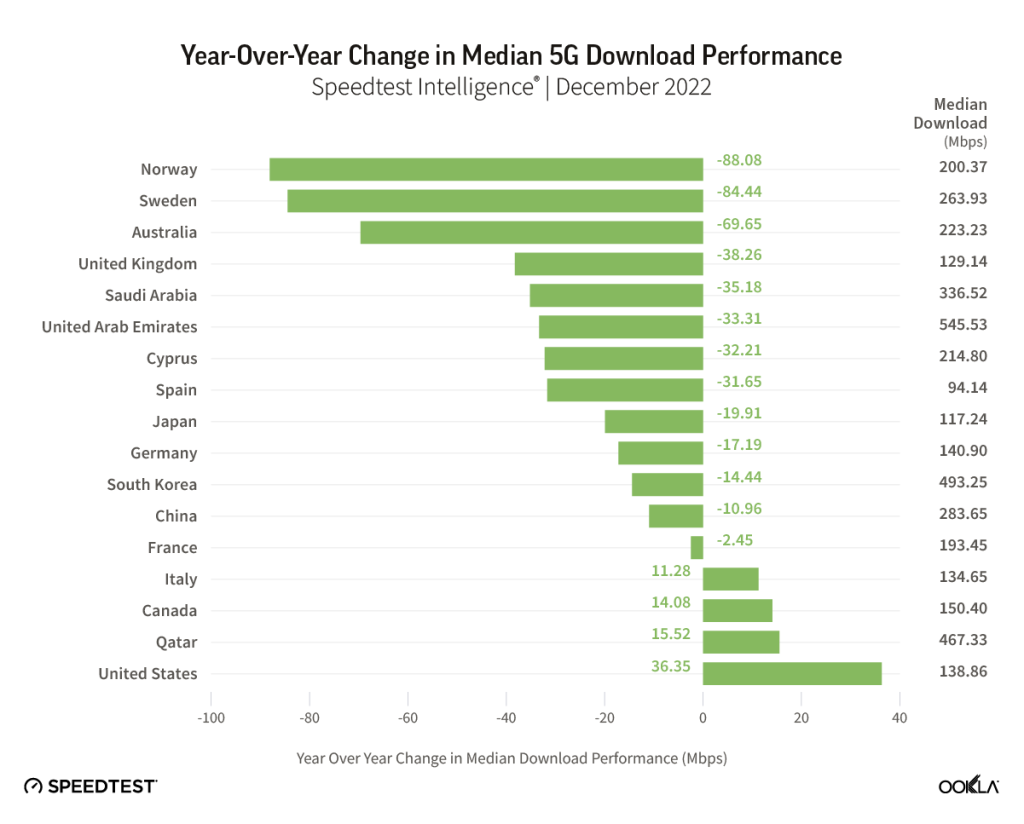5G Network Speed Slower than One Year Ago, and Millimeter Wave Difficult to Popularize
As a new generation of mobile communication technology, 5G networks should have been faster and better than 4G networks, but this is not the case. According to the speed test data of the Network tomography company Ookla, compared with a year ago, the upload and download speeds of 5G networks around the world have generally declined. Even the most advanced 5G network can currently only reach a speed of 1 Gbps, far below the ideal download speed of 20 Gbps set by the International Telecommunication Union.

According to IEEE reports, there are many reasons for this situation. Firstly, as more and more users purchase new phones and other devices, the number of people using 5G networks has increased, leading to network congestion. This is a problem that every generation of mobile communication technology will encounter. Mark, an industry analyst at Ookla? Giles said, “If you look back at the 4G era, it’s the same. So when 4G was first deployed, there was a lot of capacity available for those early users to use. Then as the number of users increased, the capacity was used up and the base station density needed to be increased
Secondly, most operators use non independent 5G networks when deploying 5G networks. This approach is to establish a 5G network on top of the core infrastructure of the existing 4G network. Although the performance of non independent 5G networks is not as good as that of independent 5G networks, their cost and difficulty are much lower because they do not need to be built from scratch. This strategy also limits the development of 5G networks, as operators can only establish 5G networks in existing base stations and other facilities.
However, cost is not the only factor, and there are also some regulatory and licensing issues that plague operators. Especially in densely populated urban areas, sometimes the biggest challenge is to find a suitable place to place a new base station.
Besides cities, there are also different problems in suburban or rural areas. One of the biggest selling points of 5G networks is the ability to utilize new frequency bands, especially the millimeter wave frequency band (24 GHz to 40 GHz), which can support lower latency and higher data rates. However, the high-frequency band also has a drawback, which is its short propagation distance. This is good for cities, but not very practical for suburbs or rural areas. As more and more places begin to use 5G networks, there will be some overall performance degradation.
Millimeter waves have not been widely used, and apart from a few countries (including the United States), millimeter waves are almost invisible in other places. Even in the United States, companies initially optimistic about millimeter wave (such as Verizon) have also turned to other newly opened bands, such as C band (4 GHz to 8 GHz). Giles said, “As of 2022, there are 140 operators worldwide with millimeter wave licenses in 24 countries. However, only 28 operators have actually deployed millimeter waves in 16 countries. So this is a very small group. Only a few operators truly pursue millimeter waves
The initial 5G download speed of 20 Gbps proposed by the International Telecommunication Union is still only an ideal solution. Millimeter wave only has some applications in places that require a large number of users to use the network simultaneously, such as stadiums and airports. However, the construction of millimeter waves as an important component of 5G networks has not been carried out, whether due to high costs or technological limitations, which has not helped 5G networks overcome their growth stage.
Of course, not all countries’ 5G networks perform poorly. Ookla’s speed test data shows that four countries are bucking the trend: Canada, Italy, Qatar, and the United States. For the United States, Giles believes that the more available new frequency bands have helped its operators maintain a leading position in the new network. For Qatar, the significant investment in the 2022 World Cup includes building a strong 5G network.
It is unknown whether the early setbacks of 5G networks will affect the development of 6G networks, but there are some possible impacts. For example, considering the unsatisfactory performance of millimeter waves, the industry may reduce investment in terahertz wave research and turn to considering how to integrate cellular and Wi Fi technologies in areas that require dense coverage.
